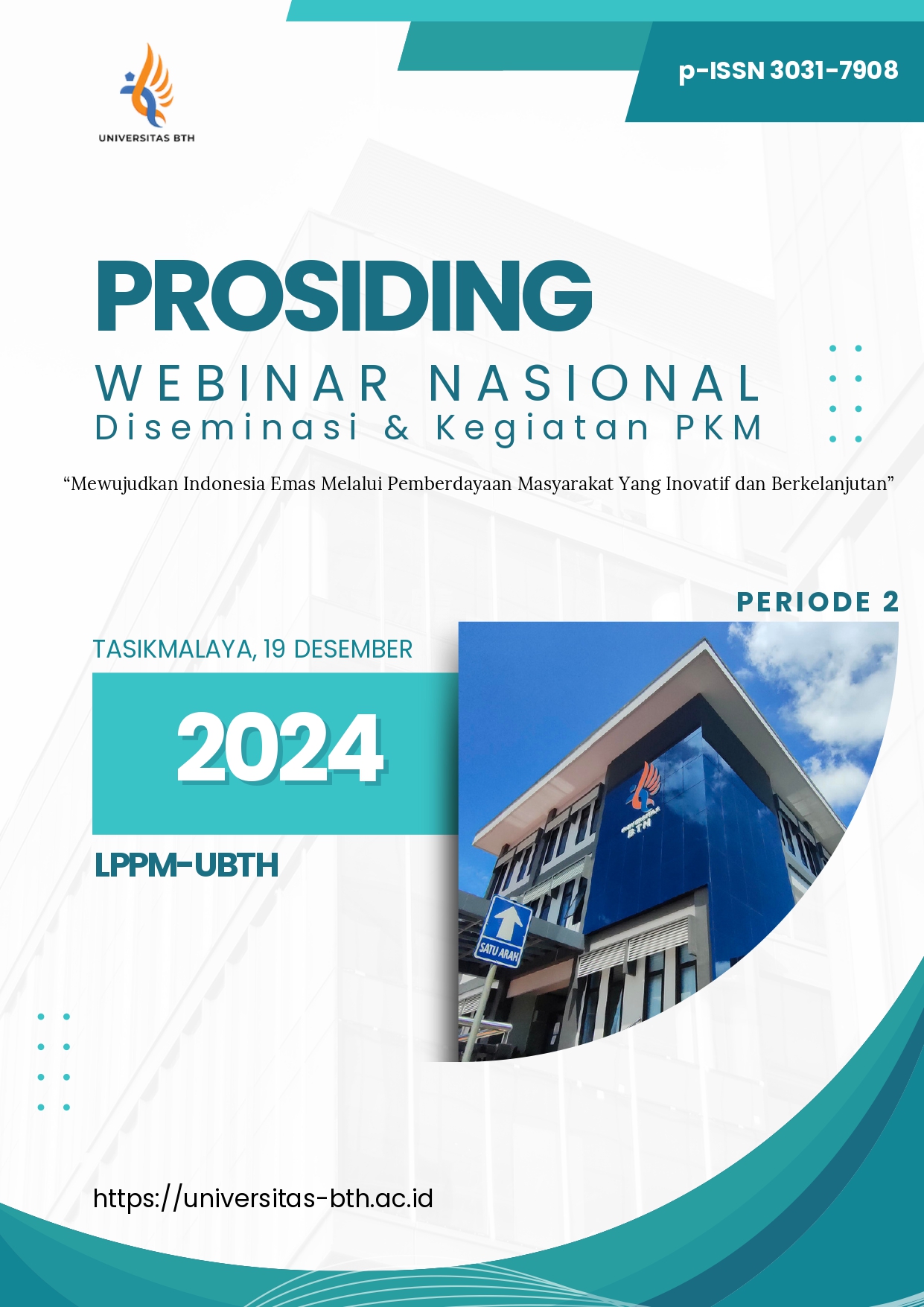PENINGKATAN KAPASITAS MASYARAKAT DALAM PENCEGAHAN DBD MELALUI PENGELOLAAN TEMPAT PENAMPUNGAN AIR
Keywords:
dengue prevention, health education, water container managementAbstract
Dengue Hemorrhagic Fever (DHF) poses a significant public health challenge in Indonesia, requiring an effective community-based prevention strategy. This community service program aimed to improve the knowledge and practices of the community regarding water storage management for DHF prevention in Sukamulya Village. A one-day educational intervention involving 61 participants, primarily housewives, was conducted at the Al-Kautsar Mosque on January 17, 2024. The program utilized health education through interactive counseling, practical demonstrations, and educational videos focusing on the Aedes aegypti mosquito life cycle, DHF risks, and the 3M Plus method (Draining, Covering, and Utilizing water containers, plus additional preventive measures). Pre-tests and post-tests were administered to assess changes in knowledge related to mosquito breeding site identification and the implementation of 3M Plus practices. The results showed a significant average knowledge increase of 16.42%, from a pre-test average of 81.86 to a post-test average of 95.29. The most substantial improvement was observed in knowledge about draining (18.52%) and covering (19.23%) practices, while the lowest increase was in the identification of breeding sites (11.76%) and the implementation of Plus actions (11.49%). This study concludes that the educational intervention effectively improved the community's knowledge about water container management for DHF prevention. However, further efforts are needed to enhance the understanding of breeding site identification and the adoption of additional preventive measures through targeted educational strategies, practical demonstrations, and sustained community engagement.
References
Alyousefi, T., Abdul-Ghani, R., Mahdy, M., Al-Eryani, S., Al-Mekhlafi, A., Raja, Y., Shah, S., & Beier, J. (2016). A household-based survey of knowledge, attitudes and practices towards dengue fever among local urban communities in Taiz Governorate, Yemen. BMC Infectious Diseases, 16. https://doi.org/10.1186/s12879-016-1895-2
Arikunto, S. (2021). Dasar-dasar evaluasi pendidikan edisi 3. Bumi aksara.
Dimas Dwi Yoga Saputra, Lundy, F., & Vania Putri Anastisia. (2024). Pencegahan Demam Berdarah Menggunakan Video Animasi terhadap Pengetahuan Siswa SDN Gadang 4 Kota Malang. Media Publikasi Promosi Kesehatan Indonesia (MPPKI), 7(4), 941–945.
https://doi.org/10.56338/mppki.v7i4.4835
Direktorat Jenderal Pencegahan dan Pengendalian Penyakit Kementerian Kesehatan RI. (2023). Laporan Tahunan 2022 Demam Berdarah Dengue.
Fauzan, A. M. (2023). Kemenkes: Ada 68.996 kasus DBD hingga Oktober 2023. ANTARA News.
Jogdand, K. S., & Yerpude, P. N. (n.d.). The Community Knowledge and Practices Regarding Dengue Fever in an Urban Slum Area of South India. International Journal of Community Medicine, 2023.
Kiswanto, K., Hanafi, A., Priwahyuni, Y., & Yunita, J. (2020). Evaluasi Pelaksanaan Kegiatan Penyelidikan Epidemiologi Dalam Program Pemberantasan Penyakit DBD Di Puskesmas Kampar. Jurnal Kesehatan Komunitas (Journal of Community Health), 6(2), 218–224.
M Monish, Saira, M., Ali, A., M. Athar, A., & Mohammad, Z. (2024). Descriptive study on knowledge, attitude and practice regarding dengue fever and its vector control in Aligarh. International Journal of Community Medicine and Public Health, 11(10).
Mawaddah, F., Pramadita, S., Arundina, A., & Tejoyuwono, T. (2022). Analisis Hubungan Kondisi Sanitasi Lingkungan Dan Perilaku Keluarga Dengan Kejadian Demam Berdarah Dengue di Kota Pontianak. In Jurnal Teknologi Lingkungan Lahan Basah (Vol. 10, Issue 2).
Tim Penyusun. (2019). Modul Pelatihan Tenaga Pelatih Kesehatan. Pusat Pelatihan SDM Kesehatan.
Auda, S., Hendrayani, N., Yulianawati, S., & Fazariah, R. (2022). Perencanaan Kegiatan mengatasi Potensi Bencana dan Masalah Kesehatan di RT 01 RW 04 Kedusunan III Desa Sukamulya Kecamatan Singaparna Kabupaten Tasikmalaya. In Auda, S dkk.
Rahman, H., Martono, A., Simarmata, M., Brata, B., & Barchia, M. F. (2023). Hubungan Faktor Kesehatan Lingkungan Rumah Dengan Resiko Kejadian Demam Berdarah Dbd Di Wilayah Puskesmas Lingkar Barat Kota Bengkulu. Naturalis: Jurnal Penelitian Pengelolaan Sumber Daya Alam Dan Lingkungan, 12(1), 59–65. https://doi.org/10.31186/naturalis.12.1.24225
Rahman, S., Mehejabin, F., & Rashid, R. (2022). Knowledge and prevention practice against dengue vectors among dengue patients and general people in Chattogram, Bangladesh. F1000Research. https://doi.org/10.12688/f1000research.108731.1
Septia Lisa, N., Suharmadji, S., Wahyudi, A., Priwahyuni, Y., & Octaria, H. (2022). Environmental Risk Factors and Community Behavior on The Event of Dengue Fever in The Work Area Payung SekakiHealth Center, Pekanbaru City. Jurnal Olahraga Dan Kesehatan (ORKES), 1(2), 110–120. https://doi.org/10.56466/orkes/vol1.iss2.11
Singh, S., Family, W., & Shamnath, M. (2029). Assessment of Knowledge, Attitude and Practices in different Socio-Economic Groups of Population on Control of Dengue and its Vectors in Delhi. The Journal of Communicable Diseases, 51(02), 16–21.

